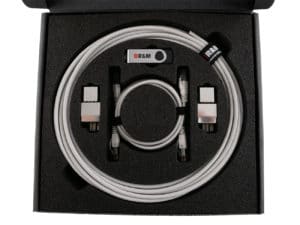Complete System: Single Pair Ethernet

The key technology in smart buildings
Single Pair Ethernet will become a key technology in smart buildings. It is the missing link for connecting devices up to sensor/actuator level by means of a standard Internet protocol (IP). It has the potential to replace existing field bus systems in the Internet of Things (IoT) in buildings or the Industrial Internet of Things (IIoT) in smart factories.
There is increasing awareness of the great significance, variety of applications, and future of Single Pair Ethernet (SPE). After SPE cleared the decisive hurdles of standardization in 2020, the broad market launch of SPE solutions is now starting.
At R&M, the development did not focus on just one of the discussed connector formats, but on an overall concept for the channel. From the outset, everything a cabling manufacturer should offer is part of the process: connectors, connection modules (for patch panels and outlets), patch cords, and installation cables.
Connector types: LC-Cu and MSP
To give planners and users complete freedom of choice, we offer two connector types:
- LC-Cu in compliance with IEC63171-1
- MSP in compliance with IEC63171-2
Robust products have been developed for both types, which can cope with the diverse and sometimes harsh conditions of use cases. R&M uses IDC wiring in the SPE connector and the SPE connection module. This resilient connectivity technology has been tried and tested millions of times in RJ45 cabling. It optimally protects the wire contact against critical environmental factors and cable movement. Naturally, the connector design also features cable strain relief and a strain relief sleeve.
Cabling experts see the LC-Cu as the connector system of choice for structured cabling systems and building automation. In the industrial environment, many companies prefer the MSP connector system with its more compact but nevertheless robust design.
LC-Cu connector system from R&M according to IEC63171-1
The front surface of the LC-Cu and MSP duplex sockets corresponds to the RJ45 cut-out. This makes it possible, for example, to create daisy-chain connections for using the 10Base-T1s protocol.
On the installation cable side, an AWG-22 type is part of the basic equipment of the SPE system. Operated with the protocol 10Base-T1L, it can reach transmission distances of up to 600 meters. The range depends on whether a remote power supply is used and at what performance level.
MSP connecor system from R&M according to IEC 63171-2
Compatible with R&Mfreenet
Full compatibility with R&Mfreenet is also part of the package right from the start. The SPE system can be combined with our universal, modular platform for structured cabling. The SPE connection modules fit into R&Mfreenet outlets and 19” panels.
In other words, planners and installers will be able to put together the right products for every application at their customers’ premises.
R&M’s goal was to be able to offer future SPE users a one-stop shopping service. And that has worked very well.
Find out more here about Single Pair Ethernet (SPE) made by R&M.
Evaluation kits for development purposes

R&M has created SPE evaluation kits for development purposes. These each contain two patch cords, two connection modules, and ten meters of installation cable.
Find out all about the Single Pair Ethernet System Alliance. The alliance consists of manufacturers of sensors, cables, connectors, measuring devices, chips, switches and terminal equipment, and education providers working together. Together, we want to establish SPE in many markets and applications. https://singlepairethernet.com/
Contact your regional R&M representative to learn more about the evaluation kits.









